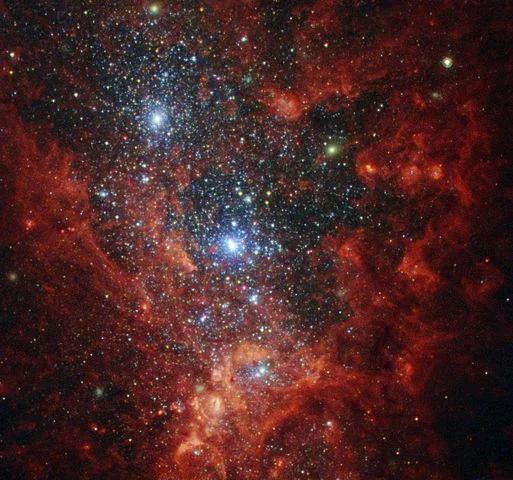NGC 1569 is a dwarf irregular galaxy found in the Camelopardalis constellation. It is one of the best known starburst galaxies in the sky. It was first discovered by William Herschel on November 4, 1788. NGC 1569 has an apparent visual magnitude of 11.9 lies at a distance of 11 million light years.
The galaxy’s spectrum is blueshifted, which means that NGC 1569 is moving toward our solar system, unlike most other galaxies, which have redshifted spectra and are therefore moving away from us (because the universe is expanding).

This NASA/ESA Hubble Space Telescope image reveals the iridescent interior of one of the most active galaxies in our local neighbourhood — NGC 1569, a small galaxy located about eleven million light-years away in the constellation of Camelopardalis (The Giraffe). This galaxy is currently a hotbed of vigorous star formation. NGC 1569 is a starburst galaxy, meaning that — as the name suggests — it is bursting at the seams with stars, and is currently producing them at a rate far higher than that observed in most other galaxies. For almost 100 million years, NGC 1569 has pumped out stars over 100 times faster than the Milky Way!
As a result, this glittering galaxy is home to super star clusters, three of which are visible in this image — one of the two bright clusters is actually the superposition of two massive clusters. Each containing more than a million stars, these brilliant blue clusters reside within a large cavity of gas carved out by multiple supernovae, the energetic remnants of massive stars. Image: ESA/Hubble & NASA, Aloisi, Ford. Acknowledgement: Judy Schmidt (Geckzilla)
NGC 1569 is undergoing a burst of star formation, one more intense than in any other galaxy in the Local Group. The star forming activity in NGC 1569 is believed to have started more than 25 million years ago. Even though the rate at which new stars are formed in the galaxy has declined in the last 10 million years, it is still quite high.
The starburst activity is believed to be so intense because NGC 1569 lies in the middle of a group of galaxies centered on the spiral galaxy IC 342, and the gravitational interactions are causing the gas in NGC 1569 to compress, which in turn is causing such furious starburst activity within the galaxy.
NGC 1569 is also notable for the massive star clusters discovered in it, each containing over a million stars.
The galaxy is believed to lie close to the Local Group of galaxies. Its coordinates in the sky are 4h 30 m 49.1s (right ascension), +64°50’53” (declination).